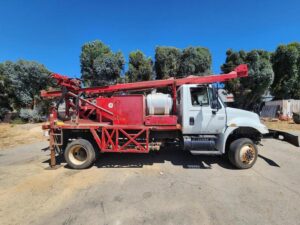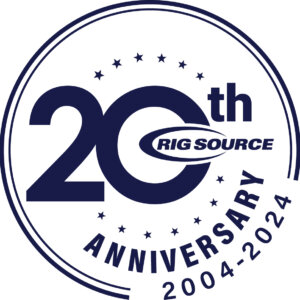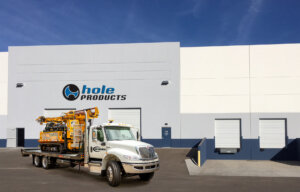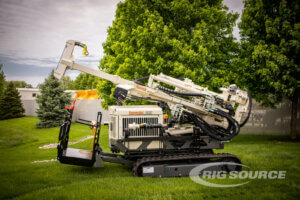Mike Crimaldi knows track carriers. He was working with crawler-mounted drills before he had a driver’s license, starting out as a driller’s helper at about age 16. As his company’s drilling fleet grew, so did its service and repair capability. Eight years ago he transitioned out of direct drilling services to found Rig Source Inc. in Elburn, Ill.
As Rig Source’s reputation for innovation grew, more and more customers wanted to pair crawler carriers with a variety of equipment that spanned the construction industry. By now Crimaldi has just about seen it all. Speaking from his 35 years of experience, he confidently summed it up: “If you can mount it to a truck, you can put it on tracks.”
Tracks provide a stable platform that keeps equipment in the field when soil and weather conditions would park truck-mounted equipment. More days in the field means owners move to the next job faster, getting more jobs completed in the same calendar time. For businesses large or small, doing more within the same period of time is the most definitive way to prove increased productivity.
Tracking the industry
Though the most common mounts still tend to be flat beds and dumpers, Crimaldi said, “One customer might have a flatbed to mount on a tracked undercarriage, the next a scissor lift. That’s the exciting thing for us, the new uses we keep seeing for it.” He has seen customers use the unit for a mulch blower, mat-carrier, mobile epoxy coating machine, hydro-seeder, mobile crane, tracked welding unit, personnel carrier, water tank carrier, and off-road service vehicle.
Crimaldi said the roots of the tracked carrier market can probably be traced back to tracked dumpers. Contractors noted how they could be used on soft, wet ground when trucks would either cause too much damage or get stuck. As trucks wore out, owners found they could extend the life and utility of their equipment by remounting it to similar tracked carriers.
“They would get maybe another five to ten years of use out of their equipment,” Crimaldi said, “but they were also finding that tracks gave them more flexibility for all ground and weather conditions.
Rain, snow – wet. They can work on their jobsites more days.”
Tracked carriers were originally designed for off-road use. Using rubber tracks eliminated the need to lay down lumber or matting to protect paved surfaces the rig might have to cross or work from. Advances in rubber track technology have made them highly durable and long lived. “Manufacturers don’t bother much with steel anymore,” Crimaldi said, “since so many customers have gone to rubber.”
Choosing a carrier
For customers deciding whether or not to mount certain equipment or which manufacturer to purchase from, Crimaldi defers to Rig Source Director of Sales Matt Slater. Slater’s job is matching customer needs to the right undercarriage. Are there cases where he’d advise against upgrading to tracked equipment? He couldn’t think of any offhand. Rubber track carriers exert as little as 3 psi of pressure on the surface. Just about anywhere a truck or trailer can go, a tracked carrier can go, and more. Though they can’t be driven to and from a worksite from the company’s parking lot, transportation isn’t much of an issue. Slater said, “Most contractors already have a trailer to haul their equipment to the site, so they’re set.”
The only limitation might be size. Track carriers come in almost any size class imaginable, he said, but the greatest customer demand has been for what he described as “the largest carrier possible without requiring special permitting to transport it.” Trailers with loads 8 feet 6 inches wide or more require oversize permits.
Demand for this size of rig has been so steady that Rig Source now manufacturers its own rubber track carrier in that class. At 8 feet 5 inches wide, the Terramac RT9 is just under the width restrictions for over-the-road trailers. It’s also the only rubber track carrier in its class made on this continent.
Slater has nothing against any of the overseas models. “Nothing wrong with them at all. They are well-engineered and we work with all of them. But, you know, many of the parts are proprietary to that manufacturer.” He explained the advantage of a wholly North American made carrier is that parts and service can be found locally throughout the U.S. and Canada.
Crimaldi agreed: “Take the engine, for example. Most North American customers are more comfortable owning a rig with a Cummins engine because they can get parts and service anywhere.”
Custom considerations
How much modification an undercarriage needs in order to accept a given mount is also an issue. Not all manufacturers can be accommodated easily. “We’ve had customers in the past who wanted to use a certain kind of winch on the front or rear of their rubber track carrier. The problem with some models was, they had to literally cut off the carrier’s bumper to be able to mount the winch.”
When customers order their carrier from Rig Source, however, they give the specifications for what they want mounted up front. Rig Source most often works directly with the original equipment manufacturer to ensure that the bolt pattern of the carrier’s bed will match up perfectly. And if customers need a specific hydraulic pump, they will specify that in the initial order.
Rig Source typically does just the carrier modification, while the equipment is mounted by the customer or the equipment’s dealer. However, Rig Source does accommodate customers who request mounting as well.
No pressure decision
Asked again to think of a scenario for which a tracked undercarriage would be an unwise choice, Slater paused to study the question. He could only think of advantages. Tracked carriers directly contribute to increased productivity, since they extend the company’s on-site calendar. They provide a stable, highly versatile platform that can turn about in place to maneuver equipment precisely where it needs to be. And they do this with significantly less threat of damage to the worksite’s surface. Even fully loaded, the company’s own 22,500-pound Terramac RT9 with its 9-ton load capacity still has a ground pressure of just 4.9 psi.
When you think about it that way, putting a rubber track carrier under your equipment does exactly what you expect any equipment upgrade to do: reduce the pressure and get you from one job to the next job much quicker.





